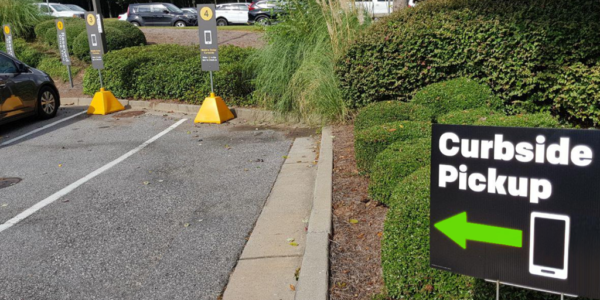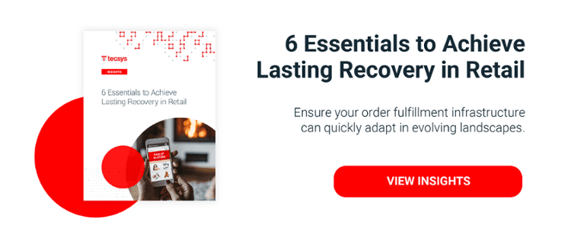Please enjoy this republication of a RETHINK Retail article.
With physical retail shopping on ice and comfort levels with in-store browsing likely to take some time to thaw, stores are jury-rigging alternative fulfillment channels that leverage their physical locations and personnel to offer social distant-friendly and contactless in-store and curbside pickup. Current makeshift operations were likely devised hastily in response to the crisis, and may not be sustainable; nonetheless, demand for curbside pickup is unlikely to diminish post-pandemic, and savvy retailers ought to use this operational disruption as a springboard for innovation.
Curbside pickup is a variation of BOPIS (Buy Online, Pickup In-Store), the core service of omnichannel retail. Facilitating curbside and BOPIS are the main reasons businesses invest in retail order management systems. Why is curbside pickup sticking around? Here are a couple of fundamental reasons why this element of omnichannel is the key to success as we move into a new era of retail fulfillment.
Equipping customers with choice
We now have more multichannel shoppers than ever before. For many, curbside debuted as a result of COVID-19, but it’s a fulfillment option that proved to be easy and convenient. Some of the resistant late adopters who were forced into non-in-store channels will revert to pre-pandemic aisle browsing, but others will embrace the streamlined approach to shopping and enjoy that buying journey more.
Retailers who make it easier to browse, buy and collect their purchases gain an advantage over the next retailer, earn market share and retain customer loyalty. By layering curbside pickup on top of e-commerce and in-store shopping, customers can seamlessly transition from one channel to the other, letting them decide which option best serves their needs for a given product or day or world event. Whatever path they choose, the levers are in place and they are in control of them.
In fact, shoppers may have product-specific preferences when it comes to fulfillment options, even within the same vertical. In the apparel industry, socks may be an easy home delivery, but you’ll want to try on those jeans. In the food industry, canned goods are perfect for curbside pickup, but you’ll want to pick out your own fresh produce.
Since all shoppers have unique preferences, this means flexibility and choice is key in unlocking the options that will keep a spectrum of shoppers happy.
Shortening the fulfillment cycle
Although processing and delivery timelines are faster than ever before, well-serviced pickup options eliminate downtime between order picking and delivery scheduling. This is both a perceived time cost benefit to the customer and a logistics benefit to the retailer. Further, it alleviates the frustrations of some online shoppers who are wary of porch pirates or live in apartments where deliveries can be a major hassle.
With effective technology in place to ensure availability, pickup orders can also be filled using in-store inventory, short-circuiting more expensive fulfillment and boosting store inventory velocity. This results in faster turnover and less carrying risk, both positives for the back of store and in-store shoppers.
Curbside pickup has the ancillary benefit of lowering the overall COGS; every customer that opts for onsite curbside pickup over free or subsidized delivery translates into shipping cost savings. Lower shipping costs means higher margins, giving retailers the flexibility to run more promotions of offer deeper discounts.
With even just a small percent of your online shoppers converting to curbside pickup shoppers, it means the sales for your chain will grow. In fact, retailers using click and collect or BOPIS showed an average growth of 23% in sales.
Strengthening customer bonds
A shopper’s end-to-end buying experience drives their loyalty to a brand. While many shoppers are fickle, the retailers that deliver on a net positive buying experience will gain and retain market share. This calls for a customer-centric, flexible and easy transaction. Curbside pickup isn’t a silver bullet, but it is a tool that delivers on customer demand.
Despite all the talk about omnichannel retail, many, if not most retailers are still not there yet. With e-commerce giants experiencing fulfillment bottlenecks and in-store shopping facing an extended slowdown even after reopening, pickup options are proving to be the hallmark of resilient retailers. Those who are equipped to fulfill orders at the curbside are meeting and exceeding customer expectations, and brand loyalty is being forged.
A watershed moment for retail transformation
Curbside pickup is not the only omnichannel retail option that is gaining momentum right now. Others, like ship-from-store, ship-from-DC, BOPIS and DTC are having their moment in the spotlight as well. While true seamless omnichannel retail is still in the early stages of mass deployment, COVID-19 has accelerated a retail disruption that was already in the offing.
Some retailers will fail to adapt and lose shoppers of every generation. Others will lean into this market evolution and thrive. As omnichannel frontrunners demonstrate their capacity to pivot from in-store shopping and weather this pandemic, retailers of all creeds need to realize that success in the months and years to come will depend on an ability to meet shifting customer buying preferences.





